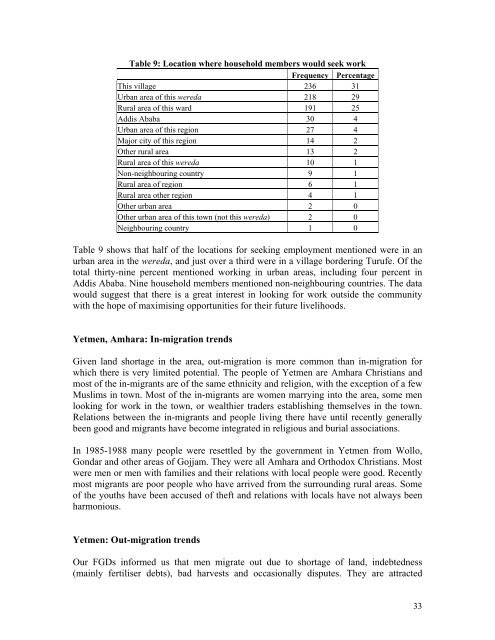Migration and Rural-Urban Linkages in Ethiopia
Migration and Rural-Urban Linkages in Ethiopia - Ethiopian Review
Migration and Rural-Urban Linkages in Ethiopia - Ethiopian Review
You also want an ePaper? Increase the reach of your titles
YUMPU automatically turns print PDFs into web optimized ePapers that Google loves.
Table 9: Location where household members would seek workFrequency PercentageThis village 236 31<strong>Urban</strong> area of this wereda 218 29<strong>Rural</strong> area of this ward 191 25Addis Ababa 30 4<strong>Urban</strong> area of this region 27 4Major city of this region 14 2Other rural area 13 2<strong>Rural</strong> area of this wereda 10 1Non-neighbour<strong>in</strong>g country 9 1<strong>Rural</strong> area of region 6 1<strong>Rural</strong> area other region 4 1Other urban area 2 0Other urban area of this town (not this wereda) 2 0Neighbour<strong>in</strong>g country 1 0Table 9 shows that half of the locations for seek<strong>in</strong>g employment mentioned were <strong>in</strong> anurban area <strong>in</strong> the wereda, <strong>and</strong> just over a third were <strong>in</strong> a village border<strong>in</strong>g Turufe. Of thetotal thirty-n<strong>in</strong>e percent mentioned work<strong>in</strong>g <strong>in</strong> urban areas, <strong>in</strong>clud<strong>in</strong>g four percent <strong>in</strong>Addis Ababa. N<strong>in</strong>e household members mentioned non-neighbour<strong>in</strong>g countries. The datawould suggest that there is a great <strong>in</strong>terest <strong>in</strong> look<strong>in</strong>g for work outside the communitywith the hope of maximis<strong>in</strong>g opportunities for their future livelihoods.Yetmen, Amhara: In-migration trendsGiven l<strong>and</strong> shortage <strong>in</strong> the area, out-migration is more common than <strong>in</strong>-migration forwhich there is very limited potential. The people of Yetmen are Amhara Christians <strong>and</strong>most of the <strong>in</strong>-migrants are of the same ethnicity <strong>and</strong> religion, with the exception of a fewMuslims <strong>in</strong> town. Most of the <strong>in</strong>-migrants are women marry<strong>in</strong>g <strong>in</strong>to the area, some menlook<strong>in</strong>g for work <strong>in</strong> the town, or wealthier traders establish<strong>in</strong>g themselves <strong>in</strong> the town.Relations between the <strong>in</strong>-migrants <strong>and</strong> people liv<strong>in</strong>g there have until recently generallybeen good <strong>and</strong> migrants have become <strong>in</strong>tegrated <strong>in</strong> religious <strong>and</strong> burial associations.In 1985-1988 many people were resettled by the government <strong>in</strong> Yetmen from Wollo,Gondar <strong>and</strong> other areas of Gojjam. They were all Amhara <strong>and</strong> Orthodox Christians. Mostwere men or men with families <strong>and</strong> their relations with local people were good. Recentlymost migrants are poor people who have arrived from the surround<strong>in</strong>g rural areas. Someof the youths have been accused of theft <strong>and</strong> relations with locals have not always beenharmonious.Yetmen: Out-migration trendsOur FGDs <strong>in</strong>formed us that men migrate out due to shortage of l<strong>and</strong>, <strong>in</strong>debtedness(ma<strong>in</strong>ly fertiliser debts), bad harvests <strong>and</strong> occasionally disputes. They are attracted33




![to read the full report [pdf, Amharic] - Ethiopian Review](https://img.yumpu.com/52737829/1/190x245/to-read-the-full-report-pdf-amharic-ethiopian-review.jpg?quality=85)











